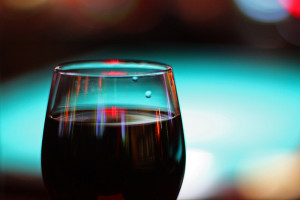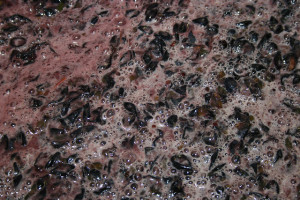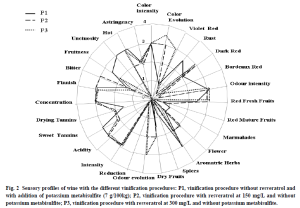Research exploring different alternatives to using added SO2 during winemaking as a result of the negative connotations associated with excess SO2 is certainly plentiful. While SO2 (a.k.a. sulfur dioxide) is naturally present in grapes and many other fruits and other foods, the addition of excess SO2 can be problematic for human health, if levels are too

Photo courtesy Flickr user U.S. Department of Agriculture
high. Specifically, people suffering from asthma tend to be at higher risk of having sulfite sensitivity or allergy, with about 3.9% of steroid-dependent asthma patients having the greatest risk. In most winemaking regions, the levels of added SO2 in wine are closely monitored and regulated, but unfortunately for a very small minority, even the amounts currently present in most wines is too much.
Sulfites are used in winemaking as antioxidants and antimicrobial agents, which aid in the preservation and aging potential of the finished wine. On average, amounts of sulfites added to wines are about 30 to 90 parts per million. As a result of technological advances, many researchers and wineries are experimenting with lowering or eliminating added sulfites in their wines, since the risk of damage to the wine is significantly reduced with modern technology and practices. Additionally, some have looked toward replacing sulfites in wine with other natural compounds (i.e. polyphenols like flavonols and stilbenes) so that the wine is still protected without the need for added SO2. It’s important to note that SO2/sulfites are naturally occurring in grapes and wine, and the SO2/sulfites we’re talking about here are ADDED sulfites.
A new pilot study, published in the Journal of Life Sciences, aimed to test a way to replace added sulfites in wine by using added resveratrol, a well-studied naturally-occurring polyphenol in wine with antioxidant and antimicrobial properties, while at the same time testing a specific method for getting the added resveratrol into the wine. This was a very short pilot study, so this summary should be a fast read!
Brief Methods
Cabernet Sauvignon red wine grapes from vineyards in Mendoza, Argentina were used for this experiment. At harvest, the grapes were 26.2oBrix, 4.61g/L titratable acidity, and 3.86 pH.
Three different winemaking procedures (using 100kg grapes each) were used in order to test the addition of resveratrol as a possible replacement for SO2:
- Control: No extra resveratrol added. Traditional red winemaking techniques employed, including the addition of 7g/100kg potassium metabisulfite.
- Resveratrol Treatment 1: Traditional red winemaking techniques employed, including the addition of 150mg/L resveratrol. No extra sulfites added (i.e. no addition of potassium metabisulfite).
- Resveratrol Treatment 2: Traditional red winemaking techniques employed, including the addition of 300mg/L resveratrol. No extra sulfites added (i.e. no addition of potassium metabisulfite).
With the exception of the added sulfites and added resveratrol, all procedures and ingredients were identical for all three treatments.
Resveratrol was added to the appropriate treatments as β-cyclodextrin complex microcapsules.

Photo courtesy Flickr user David Syzdek
Potassium metabisulfite and resveratrol capsules were added at the crusher/destemming phase of the winemaking process.
After fermentation, all wines were clarified and racked once, then used for analysis a week later.
The following characteristics were measured and analyzed for all wines: pH, dry matter content, alcohol levels, titratable acidity, volatile acidity, sugar levels, dry extract, free and total SO2, color intensity, and trans-resveratrol levels.
A sensory analysis by 10 experienced judges was also performed on the experimental wines. Each wine was sampled in triplicate.
Results
- No differences were found in the physical and chemical properties of Cabernet Sauvignon wines when comparing all three winemaking treatment procedures.
- Fermentation kinetics was the same for all three winemaking treatment procedures.
- Nearly all sensory characteristics were identical between the wines made from the three winemaking treatment procedures with the exception of color intensity.
- Color intensity was highest in the 300mg/L resveratrol treatment.
- The final resveratrol content for the three winemaking procedures was: 2.42mg/L (Control: no resveratrol added), 34.81mg/L (Treatment 1: 150mg/L resveratrol added), and 93.85mg/L (Treatment 2: 300mg/L resveratrol added).
- Percent recovery of resveratrol was between 25% and 30%.
- This means of the total amount of resveratrol added at the beginning of Treatments 1 & 2, about a quarter to a third of it remained in the final wine.
Conclusions

Figure 2 from Pastor et al (2015)
According to the results of this study, adding resveratrol capsules in the crusher/destemming point of the winemaking process increases the amount of resveratrol in the finished wine, with about ¼ to 1/3 of the original added resveratrol remaining in the finished product. The addition of resveratrol did not appear to negatively influence any physical or chemical properties of the finished wine, nor did it appear to affect the fermentation kinetics.
Physical, chemical, and sensory characteristics of the added resveratrol treatment wines were nearly identical to the control wines that used added SO2 (in the form of potassium metabisulfite). The only difference between the treatments came in the form of color intensity, with the 300mg/L added resveratrol treatment wines showing stronger color intensity than the other two treatments.
Interestingly, from these results, the authors claimed that added resveratrol could be a feasible alternative to added sulfites in wine. However, I don’t believe they can actually make this statement, since they didn’t actually study whether or not the added resveratrol would protect the wine in the same way that the sulfites did (nor did they test wine aging).
What they can say is that added resveratrol did not change any of the chemical or physical characteristics of the wine (other than a slight color intensity increase in with the greatest dose of resveratrol), but based on this particular study, they can’t say that it’s a feasible alternative to SO2 in regards to protection of the wine. Sure, they can say it’s possible, since resveratrol is a known antioxidant and antimicrobial agent, but without the actual tests and data to back that up, that certainly can’t be said for sure.
This study does show, however, that adding resveratrol as microcapsules at the crusher/destemming step of winemaking DOES increase the resveratrol content of the finished wines, thus potentially making them marketable as resveratrol-enriched wines for health purposes.
More research needs to be done to determine if added resveratrol can protect the wine in the same way that added sulfites does over time, but preliminary results of this pilot study are promising.
